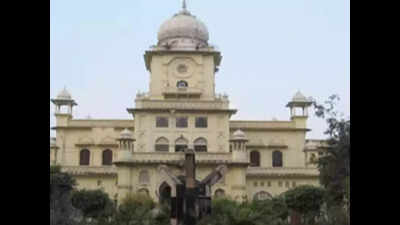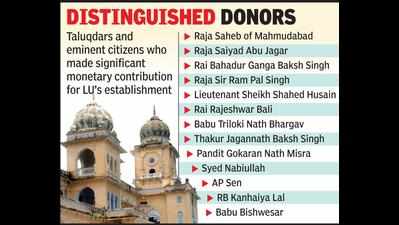- News
- City News
- lucknow News
- Crowdfunding for 57 years gave birth to elite Lucknow varsity
Trending
This story is from November 12, 2019
Crowdfunding for 57 years gave birth to elite Lucknow varsity
Long before the term ‘crowdfunding’ became popular in the early 21st century, the practice of funding a project by raising small amounts of money from a large number of people was witnessed during the establishment of a school that graduated into a college and then became a university of indisputable repute.
LUCKNOW: Long before the term ‘crowdfunding’ became popular in the early 21st century, the practice of funding a project by raising small amounts of money from a large number of people was witnessed during the establishment of a school that graduated into a college and then became a university of indisputable repute.
In 1864, voluntary deduction of eight anna (half a rupee) from the annual income of taluqdars gave birth to Canning High School in Aminabad.It took 57 more years of generous donation of cash, land and even war bonds (debt securities issued by a government to finance military operations and other expenditure in times of war) to turn the two-room school into the first campus of University of Lucknow (LU).

Dated March 21, 1921, the minutes of the first annual meeting of LU court gives a detailed account of how funding was rustled up. In our e-age parlance, how the varsity came into being through ‘crowdfunding’.
This oldest surviving LU document further states: “Cash collections up to date (March 19) amount to Rs 12.88 lakh… Of this, Rs 2.43 lakh has been placed in a fixed deposit. The balance is either in the Imperial Bank or in the district treasuries.” The statement of finance was issued by LU’s first honorary treasurer EAH Blunt.
The fascinating story of ‘crowdfunding’ even before the term’s etymological origin also unfolds in the first journal of LU published in September 1922.
It says the idea of starting a university was mooted by Raja Sir Mohammad Ali Khan, Khan Bahadur, Knight Commander (KCIE) of Mahmudabad, who contributed an article to The Pioneer, urging the foundation of the University of Lucknow. In 1919, governor of United Provinces Sir Harcourt Spencer Butler played catalyst and proposed the funding scheme for the new varsity.
A general meeting of the British Indian Association in connection with the proposed university was held in Kaiserbagh on February 4, 1920. It was announced that an advance of nearly Rs 11 lakh for the establishment of LU had been pooled in. The sum included contributions from the Maharaja of Balarampur (Rs 3 lakh), Raja of Mahmudabad (Rs 1 lakh), Raja of Jehangirabad (Rs 1 lakh), Rani of Mahomadi (Rs 1 lakh), Raja of Utranla (Rs 1.10 lakh) and Sir Harman Singh (Rs 50,000).
All those who made donations of Rs 25,000 and above were made lifetime members of the LU court, says the journal. Sir Butler appealed for another Rs 50 lakh.
The event was covered by esteemed national dailies. According to newspaper reports on February 6, 1920, the taluqdars expressed their gratefulness to Butler for accepting their request to establish “a university for the benefit of the people of Oudh”.
In 1864, voluntary deduction of eight anna (half a rupee) from the annual income of taluqdars gave birth to Canning High School in Aminabad.It took 57 more years of generous donation of cash, land and even war bonds (debt securities issued by a government to finance military operations and other expenditure in times of war) to turn the two-room school into the first campus of University of Lucknow (LU).

Dated March 21, 1921, the minutes of the first annual meeting of LU court gives a detailed account of how funding was rustled up. In our e-age parlance, how the varsity came into being through ‘crowdfunding’.
“The total sum promised in subscription up to 19th March, 1921, as reported by the Commissioner of Lucknow and the secretary of Lucknow University funds committee amounts to Rs 29,60,459, inclusive of the two donations announced by His Excellency, The Governor, at the ceremony of the laying of the foundation stone. Of this sum, Rs 1,70,225 has been received in war bonds,” the minutes read.
This oldest surviving LU document further states: “Cash collections up to date (March 19) amount to Rs 12.88 lakh… Of this, Rs 2.43 lakh has been placed in a fixed deposit. The balance is either in the Imperial Bank or in the district treasuries.” The statement of finance was issued by LU’s first honorary treasurer EAH Blunt.
The fascinating story of ‘crowdfunding’ even before the term’s etymological origin also unfolds in the first journal of LU published in September 1922.
It says the idea of starting a university was mooted by Raja Sir Mohammad Ali Khan, Khan Bahadur, Knight Commander (KCIE) of Mahmudabad, who contributed an article to The Pioneer, urging the foundation of the University of Lucknow. In 1919, governor of United Provinces Sir Harcourt Spencer Butler played catalyst and proposed the funding scheme for the new varsity.
A general meeting of the British Indian Association in connection with the proposed university was held in Kaiserbagh on February 4, 1920. It was announced that an advance of nearly Rs 11 lakh for the establishment of LU had been pooled in. The sum included contributions from the Maharaja of Balarampur (Rs 3 lakh), Raja of Mahmudabad (Rs 1 lakh), Raja of Jehangirabad (Rs 1 lakh), Rani of Mahomadi (Rs 1 lakh), Raja of Utranla (Rs 1.10 lakh) and Sir Harman Singh (Rs 50,000).
All those who made donations of Rs 25,000 and above were made lifetime members of the LU court, says the journal. Sir Butler appealed for another Rs 50 lakh.
The event was covered by esteemed national dailies. According to newspaper reports on February 6, 1920, the taluqdars expressed their gratefulness to Butler for accepting their request to establish “a university for the benefit of the people of Oudh”.
End of Article
FOLLOW US ON SOCIAL MEDIA












